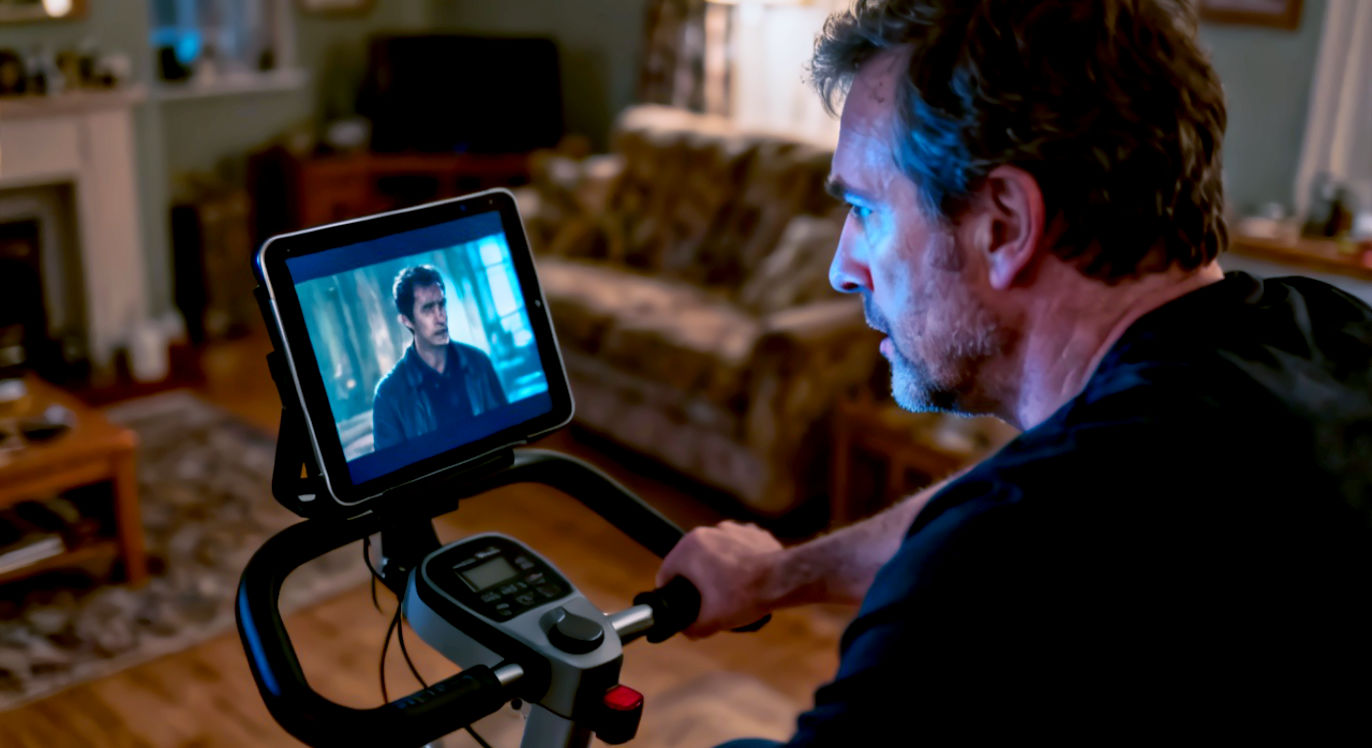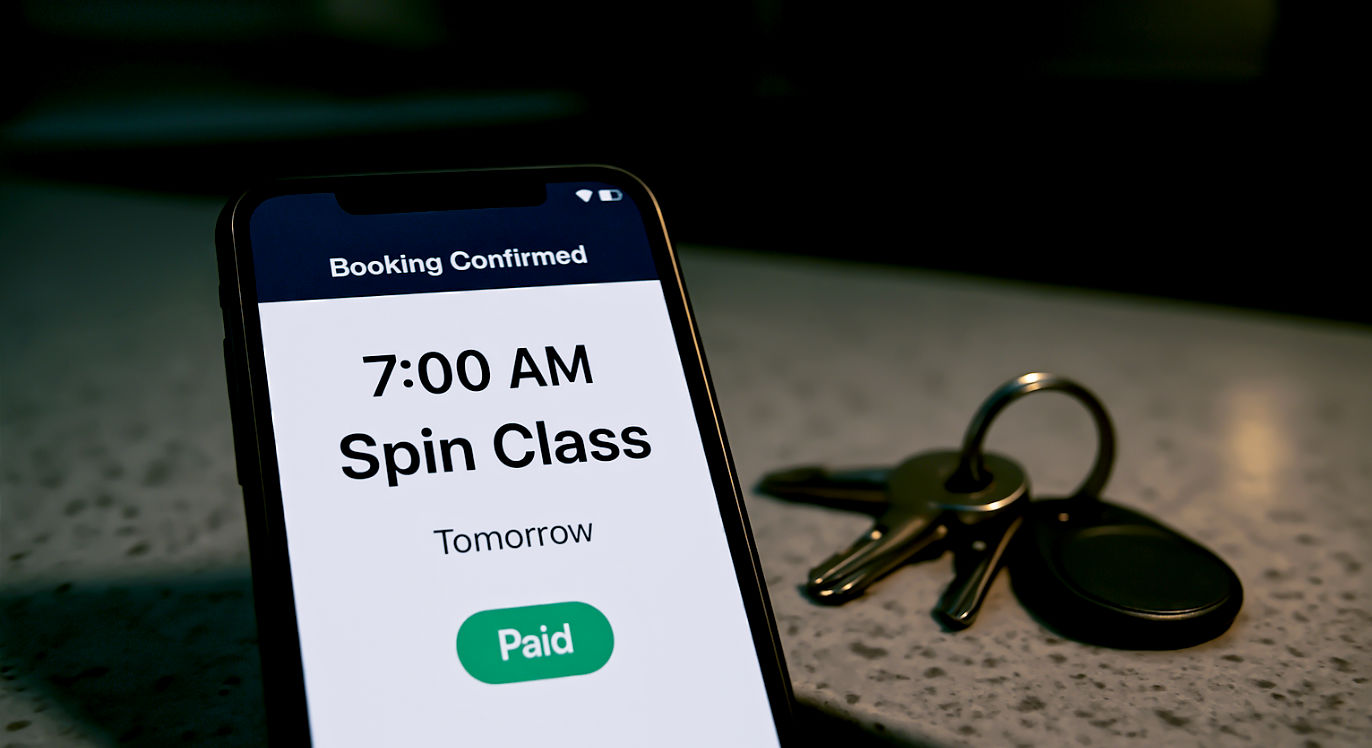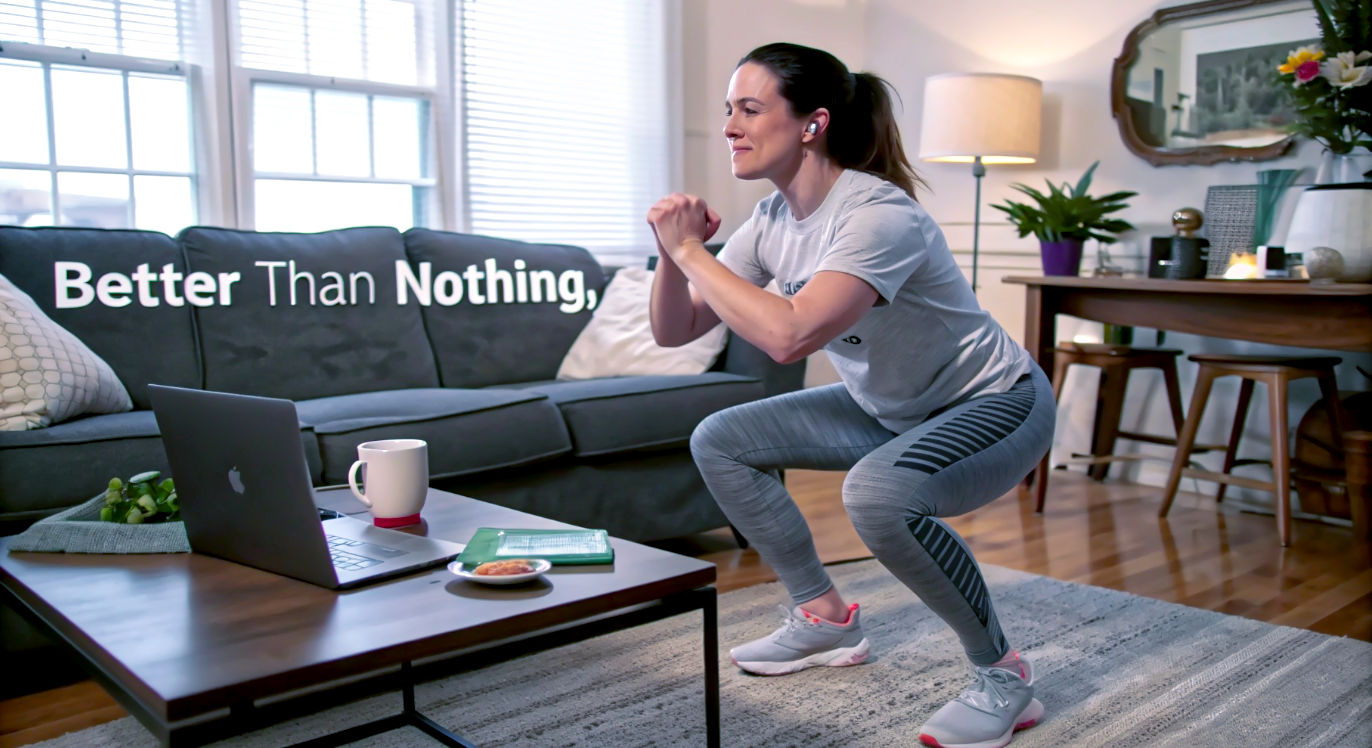This post may contain affiliate links. If you make a purchase through these links, we may earn a commission at no additional cost to you.
We’ve all been there. You buy the shiny new gym kit, download a killer playlist, and promise yourself that this is the year. For a week, you’re unstoppable. Then, a rainy Tuesday hits. The sofa looks ridiculously comfy. Suddenly, the idea of lifting something heavy feels less appealing than doing your taxes. Before you know it, your trainers are gathering dust and your gym membership is just another direct debit you try not to think about.
It’s a classic story, and it’s not your fault. Staying motivated to go to the gym is tough. Life gets in the way, progress can feel slow, and some days, you just don’t have the energy.
But what if you could change that? What if you could flip a switch in your brain that makes you want to work out?
Good news: you can. Motivation isn’t some magical force you either have or you don’t. It’s a science, driven by powerful psychological triggers that you can learn to pull. This isn’t about ‘no-pain-no-gain’ clichés or forcing yourself through miserable workouts. It’s about understanding how your mind works and using that knowledge to build a fitness habit that sticks—for good.
-
Crafted from thick, robust canvas material.
-
Spacious 40-litre capacity with multiple pockets.
-
Equipped with sturdy, comfortable shoulder straps.
-
Uses high-quality, secure YKK zippers.
-
Stylish, versatile olive green design suitable for all genders.
-
Designed by a UK-based start-up, Tiger Training.
Forget willpower. Let’s talk about brainpower. In this guide, we’ll break down 12 psychological triggers that will transform your relationship with the gym. We’ll explore simple, science-backed ‘hacks’ that make exercise feel less like a chore and more like a reward. Whether you’re a complete beginner staring at a dumbbell for the first time or a seasoned gym-goer stuck in a rut, you’re about to discover how to unlock a level of motivation you never thought you had.
Let’s get started.
The Motivation Myth: Why ‘Just Doing It’ Doesn’t Work
For years, we’ve been told that the key to fitness is willpower. We see ultra-fit influencers on Instagram and assume they’re just built differently—that they have an endless supply of grit. But that’s a myth, and it’s one that sets most of us up for failure.
Relying on sheer willpower is like trying to hold a beach ball underwater. You can do it for a while, but it takes a huge amount of effort, and eventually, it’s going to pop back up. Your brain is hardwired to conserve energy and seek comfort. It’s a survival mechanism. So, when you’re tired after a long day at work, your brain will always vote for the sofa over the squat rack.
This is where most people go wrong. They try to fight their own brain, creating a battle they’re destined to lose.
The secret isn’t to fight your instincts but to work with them. The most successful people aren’t motivation superheroes; they’re just masters of habit and routine. They’ve learned to use psychological tricks to bypass the need for willpower altogether. They’ve made going to the gym as automatic as brushing their teeth.
Think about it: you don’t need a surge of inspiration to clean your teeth each morning. You just do it. It’s a non-negotiable part of your routine. By using the triggers we’re about to explore, you can make exercise feel the same way.

Intrinsic vs. Extrinsic Motivation: The Two Sides of the Coin
Before we dive into the hacks, it’s important to understand the two main types of motivation.
- Extrinsic Motivation: This is when you’re motivated by external rewards. Things like losing weight for a holiday, looking good in a certain outfit, or getting praise from others. It’s powerful stuff, and it’s often what gets us started. The problem? It doesn’t last. Once the holiday is over or you hit your goal weight, the motivation often disappears.
- Intrinsic Motivation: This is the holy grail. It’s when you’re motivated from within. You exercise because you enjoy the feeling, it relieves stress, it makes you feel strong and capable, or you love the challenge. This is the type of motivation that builds lasting habits because the reward is the activity itself.
The goal is to move from relying on extrinsic motivation to building intrinsic motivation. These psychological hacks will help you do just that.
12 Psychological Triggers to Unlock Your Gym Motivation
Ready to rewire your brain? Let’s break down the triggers that will make you consistently show up.
Trigger 1: The Dopamine Loop (Make it a Reward)
The Science: Dopamine is a chemical in your brain that plays a huge role in motivation and reward. When you do something enjoyable—like eating your favourite food or listening to a great song—your brain releases dopamine. This makes you feel good and teaches your brain to repeat the behaviour. You can hijack this system to make your brain crave workouts.
The Hack: Pair Exercise with Something You Love.
Don’t just focus on the workout itself; focus on creating a rewarding experience around it.
- Create a ‘Gym-Only’ Playlist: Make a playlist of your absolute favourite, high-energy songs that you only listen to when you’re working out. Your brain will start to associate the gym with the pleasure of listening to that music, and soon you’ll find yourself looking forward to it.
- Listen to a Gripping Podcast or Audiobook: Find a podcast or audiobook that you can’t put down, and make a rule that you can only listen to it while you’re at the gym or out for a run. If you want to know what happens next in the story, you have to show up for your workout.
- Plan a Post-Workout Treat: This doesn’t have to be food. It could be 20 minutes in the sauna, a relaxing bath with Epsom salts, or watching an episode of your favourite Netflix show guilt-free. The key is to link the workout (the effort) directly to the treat (the reward). Your brain will quickly learn the pattern: Gym = Feel-Good Reward.

Trigger 2: The Zeigarnik Effect (The Power of Incompletion)
The Science: The Zeigarnik effect is a psychological phenomenon where our brains remember unfinished tasks better than completed ones. That nagging feeling you get when you leave a task half-done? That’s the Zeigarnik effect. It creates a mental tension that pushes us to seek closure.
The Hack: Start Absurdly Small.
Your goal isn’t to have an amazing workout. It’s just to start. The mental barrier to entry is the hardest part. By making the first step ridiculously easy, you trick your brain into getting started, and the Zeigarnik effect will help you continue.
- The 5-Minute Rule: Tell yourself you’re only going to the gym for 5 minutes. That’s it. Anyone can do 5 minutes, right? It sounds so easy that your brain won’t put up a fight. What usually happens? Once you’re there, you’ve changed, you’re warmed up, and the music is playing… you’ll almost certainly stay for longer. You’ve opened the ‘loop’, and your brain will want to close it with a proper workout.
- Lay Out Your Kit: The night before, lay out your gym clothes, fill your water bottle, and pack your bag. This small act of preparation is a tiny ‘start’ to the task. It opens the loop in your mind, making it more likely you’ll follow through the next day. It reduces the ‘friction’ of getting started.
Trigger 3: Identity-Based Goals (Become the Person)
The Science: James Clear, author of the bestselling book Atomic Habits, argues that the most powerful way to change your behaviour is to change your identity. Instead of focusing on what you want to achieve (e.g., “I want to lose 10 pounds”), focus on who you want to become (e.g., “I am the type of person who is active and healthy”). Every time you act in line with that new identity, you reinforce it.
The Hack: Reframe Your Goal as an Identity.
Stop saying, “I have to go to the gym.” Start saying, “I am someone who never misses a workout.”
-
Compact A5 size (8″ x 5.6″).
-
Dedicated sections to log exercises, sets, reps, weights, and body measurements.
-
Includes 2 goal-planning pages and 4 specialised pages for pre/post-workout stats.
-
Made with premium, thick, anti-bleed paper.
-
Features a sturdy hardcover shell and a gold spiral binding.
- Focus on ‘Casting Votes’: Every time you go to the gym, you are casting a vote for your new identity. One workout won’t transform your body, but it proves to yourself that you are a person who exercises. The goal is simply to cast more votes for your desired identity each week.
- Talk the Talk: How would a healthy, active person speak about themselves? They wouldn’t say, “Ugh, I’m so lazy.” They’d say, “I’m feeling a bit low on energy today, but I know moving my body will help.” Start using the language of the person you want to become. It sounds simple, but this self-talk has a profound impact on your self-perception and, ultimately, your actions.
Trigger 4: The Fresh Start Effect (Use a New Beginning)
The Science: We are psychologically more motivated to make changes at ‘temporal landmarks’—points in time that feel like a new beginning. This could be a new year, a birthday, the start of a new month, or even just a Monday. These moments allow us to mentally wipe the slate clean and separate our new, motivated selves from our past, less-motivated selves.
The Hack: Don’t Wait for January 1st.
You can create your own ‘fresh start’ whenever you need a motivation boost.
- Use Mondays: Fell off the wagon last week? No problem. Monday is a new week. It’s a psychological reset button. Use it to recommit to your goals without any guilt about what happened before.
- Start on the 1st of the Month: If you’re having a bad few weeks, don’t write off the whole month. Wait for the 1st and treat it as your personal ‘New Year’s Day’.
- Change Your Environment: A new beginning can also be triggered by a change in scenery. Buying a new pair of trainers, trying a different gym, or even just rearranging your workout space at home can create a feeling of a fresh start and a renewed sense of motivation.

Trigger 5: Temptation Bundling (Link a ‘Want’ with a ‘Should’)
The Science: Coined by behavioural economist Katherine Milkman, temptation bundling is a strategy where you pair an activity you enjoy (a ‘want’) with an activity you should do but often avoid (a ‘should’). This makes the ‘should’ activity more appealing because it becomes a gateway to the ‘want’.
The Hack: Combine Your Guilty Pleasure with Your Gym Session.
This is a step up from the Dopamine Loop hack. It’s not a reward after the workout; it’s a reward during it.
- Binge-Watch While You Cycle: Only allow yourself to watch your favourite trashy reality TV show or gripping drama while you’re on the exercise bike or treadmill. You’ll start to look forward to your cardio sessions because they’re your ticket to entertainment.
- Save Your Favourite Podcast for Your Walk: If you love listening to a certain comedy podcast, save it for your ‘active recovery’ day walk. The desire to listen will pull you out the door.
- Socialise at the Gym: If you’re an extrovert who loves catching up with friends, find a workout buddy. The gym becomes your social time. You’re bundling the ‘should’ (exercise) with the ‘want’ (social connection).
Trigger 6: The Progress Principle (Celebrate Small Wins)
The Science: Harvard professor Teresa Amabile discovered the ‘Progress Principle’ after studying the diaries of hundreds of employees. She found that the single most powerful motivator was making progress in meaningful work. Even small, incremental steps forward can create a huge boost in mood and motivation.
The Hack: Track Your Progress and Make it Visible.
Your brain needs to see that you’re moving forward, especially on days when it doesn’t feel like it.
-
Flexible design allows you to customise dates for any year.
-
Includes a dedicated to-do list and memo area.
-
Extended and wider design for more writing space.
-
Easily erasable with a damp or dry cloth.
-
Perfect for marking important dates, from birthdays to holidays.
- Use a Habit Tracker: Get a simple wall calendar and put a big red ‘X’ through every day you complete your workout. Don’t break the chain! This simple visual creates a powerful sense of accomplishment and momentum. There are plenty of great apps for this too, like Streaks or Habitify.
- Focus on Performance, Not Just Aesthetics: The bathroom scales can be a terrible motivator because weight fluctuates for dozens of reasons. Instead, track metrics you have more control over. Keep a workout log and aim to add one more rep or lift 1kg heavier than last week. Seeing those numbers go up provides concrete proof of your progress and strength gains.
- Take Photos: Take a progress photo every 4 weeks in the same lighting and pose. You might not notice changes day-to-day, but comparing photos over a month or two can reveal transformations you never would have seen in the mirror.
Trigger 7: The Power of Community (We Are Stronger Together)
The Science: Humans are social creatures. We are deeply influenced by the behaviour of those around us. This is known as social proof. When we see others doing something, we’re more likely to do it ourselves. Being part of a group also creates a sense of accountability and belonging.
The Hack: Make Fitness a Social Activity.
Don’t try to do it all alone. Embed yourself in a community.
- Join a Class: Whether it’s CrossFit, spinning, yoga, or a boot camp in the local park, group classes are a fantastic source of motivation. The energy is infectious, the instructor pushes you, and you’re surrounded by people with the same goal. It also removes the mental effort of planning your own workout.
- Find a Workout Buddy: This is a classic for a reason. Arranging to meet someone at the gym makes you far less likely to bail. You don’t want to let them down. A bit of friendly competition can also push you to work harder than you would on your own.
- Share Your Goals: Tell a supportive friend or family member what you’re trying to achieve. Just the act of saying it out loud creates a sense of accountability. Ask them to check in with you once a week.

Trigger 8: The Precommitment Device (Lock in Your Future Self)
The Science: We are often too optimistic about our future selves. We think, “Future me will definitely have the energy to go to the gym after work.” But when the future arrives, ‘present me’ is tired and just wants to go home. A precommitment device is a choice you make in the present that locks your future self into a certain action. It’s a way of protecting yourself from your own future lack of willpower.
The Hack: Make it Harder to Back Out than to Show Up.
Create a situation where skipping the gym has an immediate, tangible consequence.
- Book and Pay for Classes in Advance: If you’ve already paid for a spinning class, you’re much more likely to go because you don’t want to lose the money. This is the principle of ‘loss aversion’—we feel the pain of a loss more strongly than the pleasure of an equivalent gain.
- Arrange to Meet a Friend: As mentioned above, this is a powerful precommitment. The social cost of letting a friend down is often a stronger motivator than the health benefits of the workout itself.
- The ‘Ulysses Pact’: In Greek mythology, Odysseus (Ulysses) had his sailors tie him to the mast so he couldn’t be lured by the deadly songs of the Sirens. You can create your own version. If you plan a morning workout, put your alarm clock on the other side of the room, on top of your gym clothes. To turn it off, you have to get out of bed and literally touch your workout kit.
Trigger 9: The Two-Day Rule (Never Miss Twice)
The Science: One missed workout is an anomaly. Two missed workouts is the start of a new, undesirable habit. Consistency is far more important than intensity, especially when you’re building a routine. The ‘Two-Day Rule’ provides a simple, clear boundary that prevents a small slip-up from turning into a complete slide.
The Hack: Forgive Yourself for One Missed Day, But Never Two.
Life happens. You’ll get sick, work will run late, or you’ll just have a day where you feel awful. It’s okay to miss a workout. The key is to not let it derail you.
-
A complete set of 9 bands: 5 loop bands (10-45lbs) and 4 pull-up bands (5-85lbs).
-
Adaptable for toning, weight management, strength training, and physio recovery.
-
Designed to target every major muscle group (arms, chest, back, legs, core).
-
Includes a travel-friendly pouch.
- Have a ‘Back-Up’ Plan: If you miss your planned gym session, what’s your non-negotiable for the next day? Maybe it’s a 20-minute walk at lunchtime or a quick bodyweight circuit at home. The goal is to get back on track immediately.
- Reframe ‘Failure’: Missing a day isn’t a failure. It’s just data. What caused it? Were you too tired? Did you schedule it at a bad time? Learn from it and adjust your plan. The only real failure is giving up completely. The Two-Day Rule gives you permission to be human, while also providing a clear instruction for how to recover.
Trigger 10: The Endowment Effect (Take Ownership of Your Fitness)
The Science: The endowment effect is a cognitive bias where we place a higher value on things we own. In one famous experiment, participants given a coffee mug wouldn’t sell it for less than £5, while another group wouldn’t pay more than £2.50 for the same mug. Once something is ours, we’re more attached to it.
The Hack: Invest in Your Fitness Journey.
This isn’t just about money; it’s about investing your time, effort, and identity. The more you invest, the more valuable it becomes to you, and the harder it will be to give up.
- Buy Quality Kit You Love: Invest in a pair of trainers that make you feel good or workout clothes you feel confident in. When you’ve spent your hard-earned money on something, you’re more likely to want to use it to get your money’s worth.
- Hire a Personal Trainer (Even for a Few Sessions): This is a significant investment of both money and trust. A good PT will not only teach you proper form but will also act as a powerful accountability partner. The financial and personal investment makes you take it more seriously.
- Master a Skill: Instead of just going to the gym to ‘get fit’, decide to master a specific skill. It could be perfecting your deadlift form, learning to do a pull-up, or holding a crow pose in yoga. Investing the time and effort to develop a tangible skill creates a deep sense of ownership and pride in your abilities.

Trigger 11: The ‘What the Hell’ Effect (Plan for Imperfection)
The Science: The ‘what the hell’ effect (or counter-regulatory eating) was first observed in dieters. When someone on a strict diet ate one ‘forbidden’ biscuit, they would often think, “Well, I’ve blown it now, I might as well eat the whole packet.” This all-or-nothing mindset is incredibly destructive for long-term goals.
The Hack: Have a ‘Better Than Nothing’ Workout Ready.
Perfection is the enemy of progress. You will have days where you can’t give 100%. The key is to abandon the all-or-nothing mindset.
- Create a 15-Minute Emergency Workout: Design a super short, simple workout that you can do anywhere with no equipment. For example: 3 rounds of 10 push-ups, 15 squats, and a 30-second plank.
- Lower the Bar: On days when you feel unmotivated, give yourself permission to do less. Instead of your usual hour-long weights session, just aim for 20 minutes of light cardio. Something is always better than nothing. It keeps the habit alive and prevents the ‘what the hell’ effect from taking over. You’ll leave feeling much better about yourself than if you’d done nothing at all.
Trigger 12: The Power of Visualization (See Your Success)
The Science: Numerous studies have shown that mental rehearsal can improve performance in sports, music, and even surgery. When you vividly imagine yourself performing an action, you activate the same neural pathways in your brain that you would by actually doing it. This mental practice builds confidence and makes the action feel more familiar and automatic.
The Hack: Mentally Rehearse Your Workout.
Take five minutes before you go to the gym to visualize your session.
- Process Visualization: Don’t just focus on the outcome (e.g., having a six-pack). Focus on the process. Close your eyes and imagine yourself walking into the gym, feeling confident and strong. Picture yourself performing each exercise with perfect form. Imagine the feeling of your muscles working and the satisfaction of finishing your last set.
- Overcome Obstacles in Your Mind: What might get in your way? Maybe the squat rack is busy. Visualize your back-up plan (e.g., doing dumbbell squats instead) and see yourself smoothly transitioning without getting frustrated. This mental preparation makes you more resilient to real-world obstacles.
Putting It All Together: Your Motivation Toolkit
You don’t need to implement all 12 of these triggers at once. Pick two or three that resonate with you and start there.
- Feeling overwhelmed? Start with the Zeigarnik Effect. Just put on your kit and do 5 minutes.
- Feeling bored? Try Temptation Bundling. Find a new podcast you can only listen to at the gym.
- Feeling like you’re not getting anywhere? Focus on the Progress Principle. Start a workout log and celebrate every extra rep.
- Feeling lonely? Lean into the Power of Community. Join a class this week.
Motivation isn’t a lightning bolt of inspiration. It’s a skill. It’s a system you build, brick by brick, by understanding your own psychology. By using these triggers, you can stop fighting your brain and start working with it. You can build a fitness habit that doesn’t rely on willpower, but on smart, sustainable strategies.
The journey to a consistent gym routine isn’t about being perfect. It’s about being prepared. It’s about having a toolkit of mental hacks to pull from on the days when the sofa is calling your name.
Now you have that toolkit. Go use it.
Further Reading
For those who wish to delve deeper into the science of habit formation and motivation, these resources are highly recommended:
- Atomic Habits by James Clear: An essential read on how small habits can lead to remarkable results.
- The Power of Habit by Charles Duhigg: Explores the science behind why we do what we do in life and business.
- Mindset by Carol S. Dweck: A groundbreaking book on the power of our mindset and how it shapes our success.
- Nudge by Richard H. Thaler and Cass R. Sunstein: Explores how we can make better choices for ourselves, our families, and our society.
- BJ Fogg’s Tiny Habits: A practical framework for making new habits easy and achievable.










